
Change management is the structured process of guiding organizations through transitions, whether it’s a new technology rollout, a merger, or a strategic pivot. Yet most companies still struggle with it. According to McKinsey, roughly 70% of change initiatives fail to achieve their goals, often due to employee resistance or lack of leadership support.
Even well-funded digital transformation programs often underperform, with only about 35% of companies meeting their targets in large-scale change efforts. These failures result in billions of dollars wasted and staff frustration. Traditional approaches (cascading memos, one-size-fits-all training, rigid timelines) often miss the mark, especially when culture and silos dominate. As McKinsey notes, shortcomings in organizational culture are one of the main barriers to company success in the digital age.
So how can leaders break this cycle? How do we adapt to change when plans stall, budgets overrun, and competitors race ahead? Is simply throwing technology at the problem enough?
This reflects the practical use of AI to streamline operations and generate insights crucial to strategic decision-making during a significant organizational change.
In this era of rapid AI advancement, the questions become urgent: Can AI help us plan better for change? Can it steer execution in real time, measure progress more accurately, and keep track of improvements?
This blog explores how AI can transform each phase of change management, from planning through sustaining, to answer those questions. Let’s dive in.
Role of AI in Enhancing Change Management Process
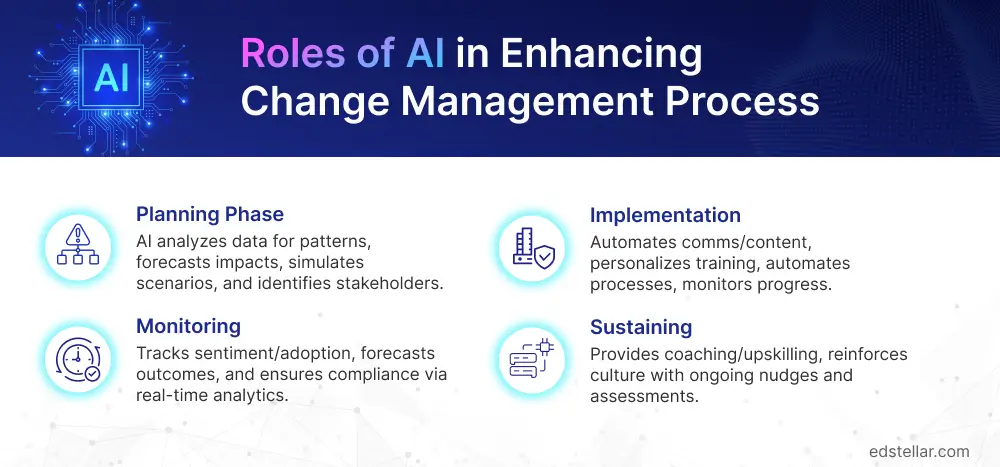
Artificial Intelligence is transforming change management by enabling leaders to make data-driven decisions, automate routine tasks, personalize communications and training, and monitor progress in real time, turning complex organizational change into a more agile, evidence-based, and continuously optimized process that can quickly adjust to feedback, predict obstacles, and sustain momentum for long-term success.
AI in the Planning Phase
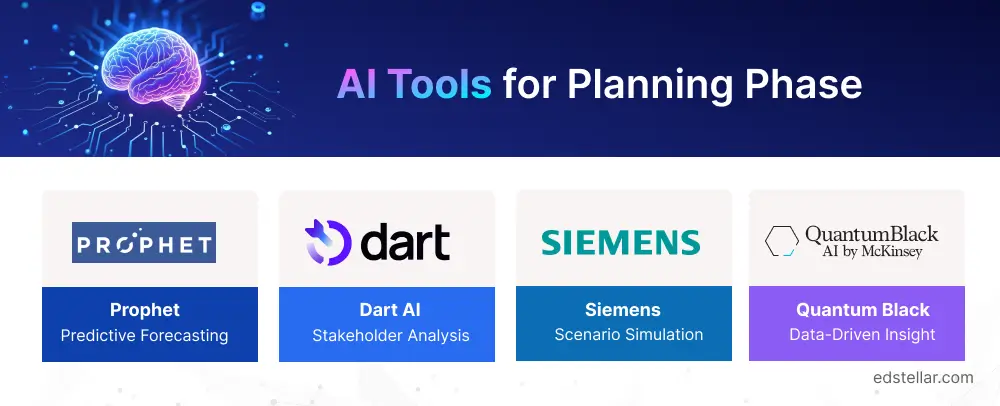
In other words, AI engines can model many “what-if” scenarios, turning guesswork into evidence-based forecasting.
- Predictive Forecasting: Machine learning models such as Prophet can predict the likely impact of a change before it happens, for example, estimating how a new digital tool will affect sales or output. This helps allocate resources where they’ll do the most good.
- Stakeholder Analysis: NLP-based tools like Dart AI can analyze employee feedback and communications (emails, chat logs, survey comments) to identify who is likely to support or resist a change. Early detection of concerns lets planners adjust the roadmap.
- Scenario Simulation: AI simulators such as Siemens Digital Twin serve as “digital twins” of business processes. For instance, an AI model might simulate rolling out a new system in one department first, showing possible delays or cost overruns. This builds confidence in the plan.
- Data-Driven Insight: AI can act as an assistant (like QuantumBlack) that automatically summarizes trends from millions of data points. It can even surface hidden connections for example, flagging that two units performing poorly share a common legacy system issue.
Equally important is preparing leaders themselves. Training executives in AI-aware planning closes the gap between technology and strategy. For example, Edstellar’s Leadership in the Age of AI course equips leaders with the skills to navigate the complexities of leading in an era dominated by artificial intelligence. Such programs blend AI ethics, strategy, and change management, ensuring planners can partner with AI tools rather than being blindsided by them.
AI During Implementation Phase
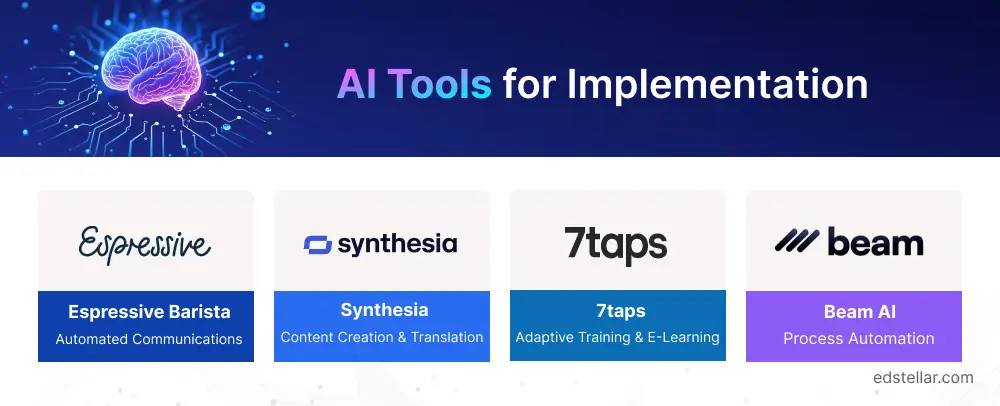
In practice, this can look like:
- Automated Communications: AI-powered chatbots and assistants such as Espressive Barista handle routine employee queries (“How do I log into the new system?”) 24/7. Generative AI can draft and refine all kinds of messages – from executive announcements to FAQ updates – tailoring tone for different groups. McKinsey advises that just-in-time feedback (giving the right info exactly when someone can act on it) is critical, and AI can automate that. For example, an AI bot might automatically send personalized tips to a sales rep struggling with new CRM software, boosting adoption rates.
- Content Creation & Translation: Change initiatives often require extensive materials (training slides, manuals, video scripts). AI engines such as Synthesia can generate first drafts or instantly translate content into local languages, massively reducing workload and speeding up rollout. Prosci research highlights that practitioners use AI to rewrite content, refine communications, and target copy to different audiences. A leader can upload a memo and get a clear summary or an email version in seconds.
- Adaptive Training & E-Learning: AI-powered learning platforms (often called microlearning, such as 7taps and adaptive learning tools such as Edstellar) adjust training material in real time. If an employee breezes through one topic but struggles with another, the system automatically recommends practice exercises. In practice, instead of generic classroom sessions, every team member receives a personalized curriculum. This personalization increases engagement – employees feel the training addresses their specific needs.
- Process Automation: Robotic Process Automation (RPA) bots, enhanced with AI, can take over repetitive tasks related to the change. For example, when new software requires migrating data from old systems, an RPA bot can move and verify records, freeing the IT team for higher‑value work. Workflows that once took days can now be monitored and executed by AI agents such as Beam AI.
Throughout implementation, AI also helps leaders monitor progress. It can update dashboards in real time (see the next section) and even flag anomalies (for instance, if uptake suddenly slows in a department). In short, AI serves as a “co‑pilot” during rollout – augmenting the human team’s ability to communicate, teach, and adapt on the fly.
AI During Monitoring & Measurement Phase

Change management must be measured continuously. AI-based analytics transform this monitoring, turning raw data into actionable intelligence.
Key applications include:
- Employee Sentiment Analysis: Modern tools like ThriveSparrow leverage natural language processing to gauge employee sentiment from pulse surveys, social channels, and collaboration tools. Instead of waiting months to learn that morale is slipping, AI can alert managers immediately if negative sentiment spikes (e.g., via text analytics on open-ended survey responses).
- Adoption Dashboards: AI-powered business intelligence platforms (such as Tableau, augmented with machine learning) can track usage data (logins, feature use, completion of training modules) and predict who is falling behind.
Prosci’s research notes that change teams use AI to analyze and segment data to customize content and to deliver real-time insights. For example, if sales reps aren’t using the new CRM feature as expected, the AI can highlight that trend mid-stream, allowing retraining on the spot.
- Outcome Simulation & Forecasting: Beyond descriptive analytics, some AI models, such as Pigment, can forecast future performance. For instance, after two weeks of rollout, an AI might predict the final adoption rate or financial benefit, based on early trends. This lets leaders adjust course proactively. It’s akin to having an “early-warning system” powered by predictive analytics.
- Compliance and KPI Tracking: In regulated industries, change often involves compliance training or audits. AI tools such as Compliance.ai and KPI Fire can automatically scan the progress of compliance checklists and even flag inconsistencies. They ensure that no critical training or certification is missed.
In sum, AI makes what you can’t measure measurable. It builds a continuous feedback loop: data is collected automatically, AI analyzes it instantly, and managers see clear visual reports. Prosci’s latest report predicts that technology use, including AI analytics, will be central to change management over the next five years, precisely because this kind of monitoring is so powerful.
AI During Sustainment Phase
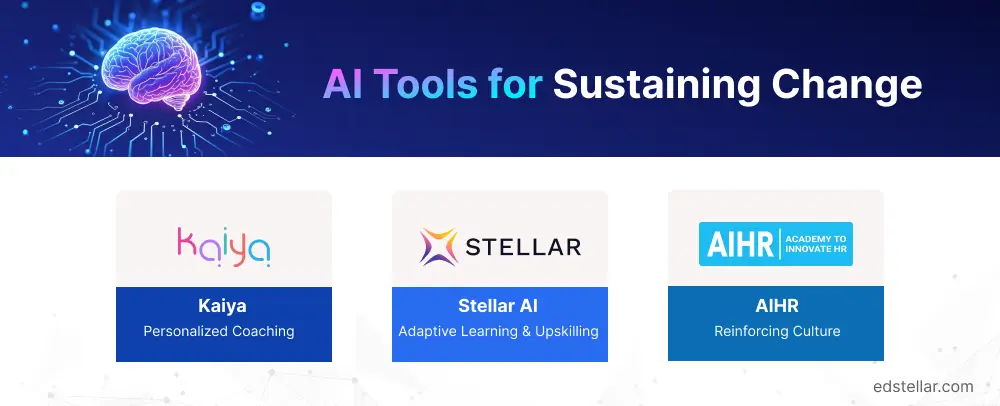
For example:
- Personalized Coaching: Just as AI can guide individual employees during rollout, it can also serve as a continuous coach. Think of virtual assistants (akin to Prosci’s own “Kaiya” tool) that check in periodically: celebrating wins, nudging laggards, and suggesting refresher training. This keeps employees engaged even after the initial launch excitement fades.
- Adaptive Learning & Upskilling: Sustaining change often means people need new skills indefinitely. AI-driven learning platforms such as Stellar AI can continuously assess skill gaps and recommend courses. For instance, after a big data initiative, an AI tutor might notice that half the team hasn’t completed an essential analytics course, and automatically enroll or remind them. This ensures the organization’s capabilities grow with the change.
- Reinforcing Culture: We know culture can erode change efforts. Here, AI can play a subtle role. For example, AI tools such as AIHR can highlight stories of on-target behavior in internal communications (via pattern recognition), reinforcing what “good change adoption” looks like. They can also measure cultural indicators – say, tracking innovation-related keywords in chat forums – so leaders know if a culture of change is taking root.
Importantly, AI cannot replace human leadership and culture – it must support them. That’s why building organizational capability is key. Training programs remain essential to sustain momentum. For example, Edstellar’s Change Management training enables professionals to understand, manage, and effectively implement change.
By combining technology with this kind of learning, companies build a culture of continuous improvement.
Key Takeaway: AI helps lock in change by acting as a smart coach and learning engine. It keeps the organization adaptive and identifies new needs. Leaders should pair these tools with ongoing training to reinforce the new ways of working.
Conclusion
Change management is complex, but new AI technologies help organizations navigate it more effectively. Data and digital tools enable adaptive, responsive approaches, turning change into a continuous journey that improves outcomes and turns insights into action. Success also relies on strong leadership, clear communication, and a learning culture. Organizations must invest in technology and upskilling to help everyone thrive in an evolving environment environments.
Edstellar, a one-stop instructor-led corporate training and coaching solution, addresses global upskilling and talent transformation needs. With 2000+ tailored programs in Technical, Behavioral, Management, Compliance, Leadership, and Social Impact skills plus IT & Technical, Management, Leadership, Compliance, Social Impact, and Behavioral training its platform includes Skill Management Software, Skill Matrix, and Stellar AI for personalized growth. Offerings like the Leadership in the Age of AI course and Change Management workshops exemplify blended learning for AI-ready teams.
Ultimately, change succeeds through empowered people, with AI as their multiplier. Organizations blending AI mastery and leadership development gain a competitive edge, as rapid adaptation is now essential.
Explore High-impact instructor-led training for your teams.
#On-site #Virtual #GroupTraining #Customized

Bridge the Gap Between Learning & Performance
Turn Your Training Programs Into Revenue Drivers.
Schedule a ConsultationEdstellar Training Catalog
Explore 2000+ industry ready instructor-led training programs.

Coaching that Unlocks Potential
Create dynamic leaders and cohesive teams. Learn more now!

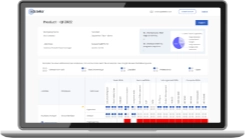
Want to evaluate your team’s skill gaps?
Do a quick Skill gap analysis with Edstellar’s Free Skill Matrix tool

Transform Your L&D Strategy Today
Unlock premium resources, tools, and frameworks designed for HR and learning professionals. Our L&D Hub gives you everything needed to elevate your organization's training approach.
Access L&D Hub Resources.svg)
.svg)



.svg)


.svg)
.svg)
.svg)
.svg)

